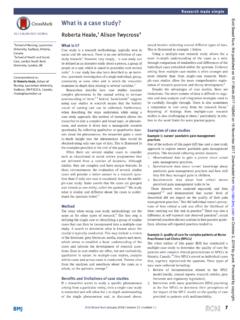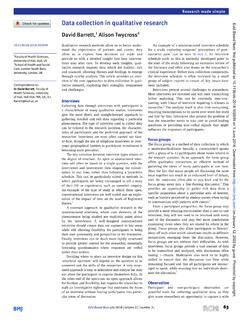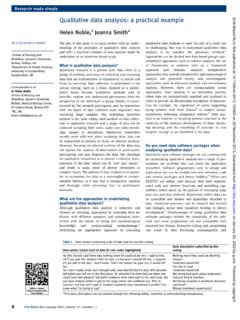Transcription of Mixed methods research: expanding the evidence base
1 Evid Based Nurs July 2017 | volume 20 | number 3 | 74 Introduction Mixed methods is a research approach whereby researchers collect and analyse both quantitative and qualitative data within the same 2 Growth of Mixed methods research in nursing and healthcare has occurred at a time of internationally increasing complexity in healthcare delivery. Mixed methods research draws on potential strengths of both qualita-tive and quantitative methods ,3 allowing researchers to explore diverse perspectives and uncover relationships that exist between the intricate layers of our multifac-eted research questions.
2 As providers and policy makers strive to ensure quality and safety for patients and families, researchers can use Mixed methods to explore contemporary healthcare trends and practices across increasingly diverse practice article will outline common types of Mixed methods designs and provide examples of how nursing researchers can apply different Mixed methods designs in order to answer important nursing practice is Mixed methods research ? Mixed methods research requires a purposeful mixing of methods in data collection, data analysis and inter-pretation of the evidence .
3 The key word is Mixed , as an essential step in the Mixed methods approach is data linkage, or integration at an appropriate stage in the research Purposeful data integration enables researchers to seek a more panoramic view of their research landscape, viewing phenomena from different viewpoints and through diverse research lenses. For example, in a randomised controlled trial (RCT) evalu-ating a decision aid for women making choices about birth after caesarean, quantitative data were collected to assess knowledge change, levels of decisional conflict, research made simple1 School of Nursing, University of Alabama at Birmingham, USA2 Children s Nursing, School of Healthcare, University of Leeds, UKCorrespondence to:Dr Allison Shorten, School of Nursing, University of Alabama at Birmingham, 1720 2nd Ave South, Birmingham, AL, 35294, USA; ashorten@ uab.
4 Edu; ashorten@ uab. eduMixed methods research : expanding the evidence baseAllison Shorten,1 Joanna 1 Types of Mixed methods designs* Mixed method typeResearch processesExamplesExplanatory sequentialQuantitative data are collected and analysed first, then qualitative data are collected and analysed to help explain quantitative dataQUAN QUALAIM: Identify levels of stress among new graduate registered nurses (RNs) working in emergency room (ER) settingsQUAN: National survey of new RNs working in ER settings measuring levels of workplace stressQUAL: Personal interviews with 15 20 new RNs working in ER settings to discuss their experiences with stressful workplace situationsSYNTHESIS: SequentialQUAL data help explain QUAN dataExploratory sequentialQualitative data are collected and analysed first, then quantitative data are collected and used to test findings empiricallyQUAL QUANAIM: Identify highest sources of workplace stress for new RNs working in hospital ERsQUAL.
5 Focus group data collected from newly registered RNs working in hospital ERs within a local area health service to discuss workplace stressQUAN: QUAL data used to create a national survey administered to all RNs working in ERs about sources of workplace stress experienced within their first year of practiceSYNTHESIS: SequentialQUAL data inform collection of QUAN data, which verify QUAL dataParallelQualitative and quantitative data collected and analysed concurrentlyQUAL + QUANAIM: Identify sources of stress for RNs working in ER settings, personal coping strategies used and types of programmes or support systems provided by hospitalsQUAN: National survey of all RNs working in ER departments, based on the literature, to identify common sources of stress and methods of support used by employers to reduce RN stressQUAL: Focus groups and interviews with a random selection of RNs working in ERs to broaden understanding of different sources of stress and personal coping strategies usedSYNTHESIS.
6 Data integration during interpretation phase after QUAN and QUAL data analysesNestedCan be either QUAL or QUAN main design with the alternative paradigm embedded within the study to answer a complementary questionQUAL + quan orQUAN + qualAIM: Test an online peer support programme designed to reduce workplace stress for new RNs working in ERsQUAN: RCT to test online programme effect on stress levels and intention to remain working in the ERqual: Interview nested in the RCT, focused on user experiences of the online programmeSYNTHESIS: qual analysis embedded within the main QUAN study*Table adapted from Halcomb and , quantitative; QUAL, qualitative.
7 On March 3, 2022 by guest. Protected by Based Nurs: first published as on 14 June 2017. Downloaded from Evid Based Nurs July 2017 | volume 20 | number 3 | 75 research made simplebirth choices and Qualitative narrative data were collected to gain insight into women s deci-sion-making experiences and factors that influenced their choices for mode of contrast, multimethod research uses a single research paradigm, either quantitative or qualitative. Data are collected and analysed using different methods within the same 7 For example, in a multi- methods qualitative study investigating parent profes-sional shared decision-making regarding diagnosis of suspected shunt malfunction in children, data collection included audio recordings of admission consultations and interviews 1 week post consultation, with interac-tions analysed using conversational analysis and the framework approach for the interview are the strengths and challenges in using Mixed methods ?
8 Selecting the right research method starts with identi-fying the research question and study aims. A Mixed methods design is appropriate for answering research questions that neither quantitative nor qualitative methods could answer 9 11 Mixed methods can be used to gain a better understanding of connections or contradictions between qualitative and quantitative data; they can provide opportunities for participants to have a strong voice and share their experiences across the research process, and they can facilitate different avenues of exploration that enrich the evidence and enable questions to be answered more Mixed methods can facilitate greater scholarly interaction and enrich the experiences of researchers as different perspectives illuminate the issues being process of mixing methods within one study, however.
9 Can add to the complexity of conducting research . It often requires more resources (time and personnel) and additional research training, as multidis-ciplinary research teams need to become conversant with alternative research paradigms and different approaches to sample selection, data collection, data analysis and data synthesis or are the different types of Mixed methods designs? Mixed methods research comprises different types of design categories, including explanatory, explor-atory, parallel and nested (embedded) Table 1 summarises the characteristics of each design, the process used and models of connecting or integrating data.
10 For each type of research , an example was created to illustrate how each study design might be applied to address similar but different nursing research aims within the same general nursing research should be considered when evaluating Mixed methods research ?When reading Mixed methods research or writing a proposal using Mixed methods to answer a research question, the six questions below are a useful guide12:1. Does the research question justify the use of Mixed methods ?2. Is the method sequence clearly described, logical in flow and well aligned with study aims?










